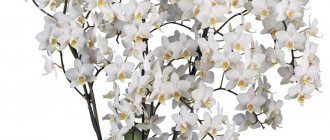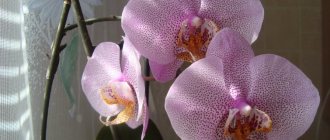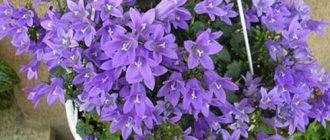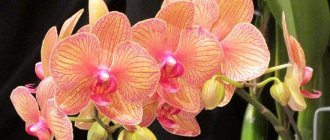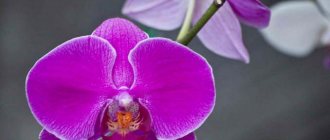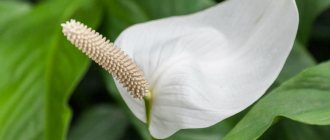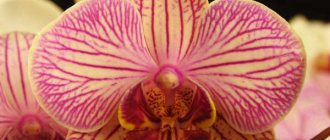External characteristics
The trunk is small, dwarf, grows up to 50 cm, it is dense and hard. The leaves have a scattering of white spots on the surface.
The flowers are small, about 4-5 cm in diameter. Petals are blue or with a lilac tint. The lip is a brighter, dark purple. The number of buds on the peduncle increases with age - they lean tightly against each other.
It is worth noting that the Sapphire variety is a phalaenopsis. In turn, Tzu Chiang is a clan name. It has many other varieties including the white (Chrisna) Krishna and the pinkish Balm.
An Expert's Warning About Buying Blue Orchids
In pursuit of orchids with rare colors, inexperienced gardeners often get into trouble. Plants with intense blue flowers are sometimes found in stores, and they are very popular. However, when buying such a copy, you need to know the following:
“Orchids genetically do not have blue pigment. Any blue orchid is dyed. Suppliers inject the peduncle with a dye that penetrates the petals. If such a plant survives, it will be white in subsequent blooms. Any conditionally blue varieties of orchids (Sapphire, Sensei Blue and others) are an optical effect that is achieved by various combinations of white, yellow and violet pigments.”
E. Rudakova, owner of the orchidarium, biologist
Pure blue or blue orchids are a product of artificial coloring. Such plants are highly susceptible to viral infections and other diseases.
Features of flowering
The orchid blooms twice a year. The duration of this period is about a month. The first flowering coincides with the onset of cold weather, the second should be expected in the spring.
If Sapphire blue does not grow buds for a long time, but is developing well, then it is stimulated.
To do this, phalaenopsis is not watered until the soil dries out, and the air temperature is reduced to 16° - in such conditions the flower is kept for 3 weeks. And then they return to normal agricultural practices.
After flowering, the plant needs special care.
- First of all, cut off the dried flower stalks. The room temperature is reduced to 20-21°, and the humidity is increased to 75%.
- After 3-4 days it will completely go into a dormant state. The temperature is lowered again, this time to 16°.
- Watering frequency is reduced to once every 7-9 days. Use complex fertilizers for orchids.
1.5 months in such conditions will completely restore the plant’s strength.
Reviews from owners of Phalaenopsis Sapphire
The Tzu Chiang Sapphire blue orchid is very popular among Russian epiphyte lovers:
“I bought Sapphire Blue at a local store on sale. It sat in damp moss, was not in the best condition, with two flowers on an almost bare peduncle, but the root was more or less normal. At home, I very quickly dropped the flowers and dried out the peduncle. I transplanted it into fine bark mixed with Chilean moss. I “thought” for a month, and now I have grown an arrow. I counted 15 buds on it. It seems to be a good variety, with strong immunity, not capricious” (Valentina, Stavropol).
“I received a Sapphire from Thailand on order. It has taken root well in its new location and has recently bloomed. Only for some reason it has lilac flowers. But still, beautiful!” (Anna, Irkutsk).
Indeed, sometimes Sapphire blue produces flowers that are not white with a tint, but distinctly lilac. This usually happens in the second generation, in plants obtained from seeds. Therefore, it is better to propagate this variety vegetatively. Children completely inherit the color and other properties of the mother plant.
Sapphire blue with lilac petals is a deviation from the ideal flower color of this variety. However, such a plant is also pleasing to the eye and looks very decorative.
Conditions of detention
Phalaenopsis needs certain conditions:
- Daytime temperatures from 20 to 26°; night - from 15 to 17°.
- Air humidity is within 60-70%.
- Good ventilation without drafts and cold wind.
- Illumination is high, at least 10 hours a day. At the same time, the flower does not like direct rays.
- Special soil is needed for orchids. In summer, transplantation into open ground is allowed.
- The pot for planting is not too large. The root system should fit completely into it, leaving a width of 1-2 fingers from the walls.
If the leaves have acquired a rich green color, this is a signal that the plant does not have enough light. With light green, yellow and light shades, it is worth putting it in a more shaded place.
Preparing for landing
Phalaenopsis Sakura Lewis cannot be planted in regular soil. Ordinary soil is not able to hold the orchid so that it remains in an upright position and poorly allows oxygen to pass through it. It is better to plant the crop in pine bark. Before planting, the soil must be disinfected. For this, use a manganese solution (4 g per 10 liters of water).
Phalaenopsis Sakura Lewis is a light-loving orchid. Even the root system needs a lot of light, so transparent containers are used for planting. Ordinary glass jars or transparent plastic food containers are often used as pots.
Reproduction methods
The culture is propagated by seeds and shoots. The first method is suitable for experienced gardeners, since it requires a fair amount of accuracy and compliance with more conditions than the second.
Seeds
Phalaenopsis seeds are very small and sensitive to the slightest fluctuations in external conditions. Because of this, it is necessary to sterilize all containers and instruments before work.
In addition, the seeds do not have their own endosperm, which makes it difficult to absorb nutrients from the soil. For this reason, it becomes more difficult to germinate them.
To reproduce using this method you will need:
- Glass flasks or jars.
- Cotton wool.
- 10% solution of bleach or potassium permanganate.
The plant needs a lot of light
You will also need a nutrient solution. Cooking diagram:
- 500 ml of water is brought to a boil.
- Add 8 g of agar-agar and 10 g of glucose and fructose.
- Stir until dissolved over medium heat.
- Boil 500 ml of water in a second saucepan.
- The fire is extinguished, 5 drops of Kornevin, 1.2-1.5 g of nitroammophoska, 1 crushed coal tablet are added.
- Mix everything and cool.
Acidity should be between 4.9-5.2 pH. To reduce it, use potash solution, to increase it, orthophosphoric acid.
Stages of seed germination:
- 30-35 g of nutrient mixture is poured into sterilized containers, sealed with cotton wool and foil, and sterilized again.
- Everything is left for 5-6 days. If mold appears inside, the flask is not used in the future.
- The seeds are treated with a 10% solution of bleach or a weak solution of potassium permanganate.
- Sow in a container with a nutrient mixture.
- Clean in a room with a temperature of 18 to 23 degrees and sufficient lighting for about 13 hours a day.
Sprouts appear over a long period of time. The first ones hatch after 3 weeks, the last ones after 3 months. They are transplanted into a new nutrient solution, where they are grown until they are fully planted in the ground.
Rostcom
You will need:
- Transparent container. A sufficient amount of light will pass through its walls for the proper development of roots.
- Soil for phalaenopsis or natural soil. Florists recommend using the bark of coniferous plants.
The drainage is laid out at the bottom of the container in a layer of at least 5 cm to ensure ventilation. The root system of the seedling is straightened, then covered with substrate and watered. Depth of occurrence is about 6 cm.
For a week they put it in the dark with a flow of air. Then place it on a windowsill or other well-lit place without direct sunlight. Water once every 10 days for 3 months, after which they switch to standard agricultural technology.
You can grow sprouts yourself from seeds or take those that sprout near adult plants.
Names of the best groups
Hybrids
Hybrids or mixes bring together a huge number of phalaenopsis of the most diverse, often unusual colors, which are bred both on the basis of varietal plants and as a result of crossing already obtained hybrids.
Here are some of them:
Anaconda
Anaconda. A flower up to 20 cm high with a delicate aroma and slightly rough leaf plates, along which vertical relief stripes run from the growing point to the end. The diameter of the flowers, which have a rich, bright yellow tint, does not exceed 6 cm. The surface of the petals is covered with a circular pattern of burgundy-colored specks, larger at the base, and the flower lip is also burgundy.
Mukalla
Mukalla. It has branching fleshy roots of a gray-green color and from 4 to 8 smooth green leaves of an asymmetrical oval shape, the length of which reaches 30 cm and the width is 10–12 cm.
The plant has from 1 to 4 peduncles 35–51 cm high. On them, medium-sized (4–5.5 cm) flowers with petals of a bright purple or lilac-violet hue and a red or dark red lip are located symmetrically on both sides. Flowers bloom sequentially, starting from the base, over 2–4 days.
Monaco
Monaco. Multifloral hybrid 45–55 cm high with sandy or grayish-brown petals, a white center and a yellow lip with a white tip. This orchid can have from 2 to 4 flower stalks.
Big Lip
Big lip, which means “big lips”. It got its name because of the large, unfolded, almost flat flower lip of a complex figured shape. This subspecies has several peduncles reaching a height of 70–80 cm, dense rich green leaves and large (up to 12 cm in diameter) flowers.
Golden
Phalaenopsis golden is a subspecies whose varieties are characterized by yellow shades of inflorescences, from lemon to golden. A plant with thick roots and large leaves blooms several times a year for two months, producing 2-3 flower stalks 75 cm tall. You can learn about popular varieties of golden phalaenopsis of the Golden group here.
Sogo
Sogo brings together varieties of phalaenopsis that belong to variegated plants, that is, those whose foliage is unevenly colored and is most often white-green, green-violet or green-red. The flowers of Sogo varieties are usually variegated, with stripes, specks or specks on a purple, white, yellow or lilac background, but monochromatic ones are also found.
Multiflora is a group of multi-flowered phalaenopsis hybrids with branching peduncles (up to 3 pieces) 60 cm high, producing up to 25 inflorescences. The leaves of representatives of this subspecies have a rich green color and reach a length of up to 35 cm. The adult plant itself looks like an airy flower bouquet. What colors does multiflora come in and how to care for it, read here.
Care
Flower growers call improper care the most common mistake. It provokes the appearance of parasites and diseases, which often lead to the death of the plant.
It’s not enough to buy a phalaenopsis; you also need to know how to care for it.
Fertilizers
When feeding the plant, it is necessary to follow the recommendations for applying fertilizers. If there are too many of them, the phalaenopsis will begin to wither, while if there is not enough, it will not fully bloom.
The table shows how to use some fertilizers:
| Term | Type of feeding | Proportions | Submission rules | Action |
| Before flowering | Combi-lux | 10 g per 1 l | Water once every 10 days. | Stimulates the appearance of flowers and generally strengthens plants. |
| In summer | Special fertilizer for orchids | Twice less than indicated on the drug label | Fertilize before watering, about once a week | Ensures normal development, stimulates the appearance of young leaves and shoots. |
Trimming scheme
Pruning of inflorescences is carried out only after they have completely dried. When the arrows dry, they are completely removed, capturing a little living twig. Dried flower stalks are removed, leaving 2 cm from the base of the rosette.
If the root system outgrows the flower, it must be replanted.
Phalaenopsis is pruned when it blooms excessively to give it a rest and gain strength. Some gardeners recommend giving the flower a fasting period, deliberately cutting off the flower stalks every 1-2 years.
Watering
Watering with water at room temperature, standing for 24 hours. A dry and wet period is required.
In the summer, half-hour baths are arranged, no more than once every 2 weeks. To do this, the dried root system is placed under the shower and watered until it turns green. Otherwise, the plant is moistened as the soil dries, at intervals of 2-3 days.
In winter, watering is reduced and carried out every 6-7 days.
Preparing for winter
Sapphire does not have a dormant period, unlike other varieties. On the contrary, the first frost is a signal for the flower to bloom profusely.
To make the plant feel comfortable, it is worth:
- protect it from cold air;
- reduce watering;
- add fertilizer if necessary.
Transfer
An orchid is replanted if: the root system has outgrown the pot and no longer fits in it; or the nutrient substrate has lost its properties or is decomposing. It is not recommended to carry out the procedure more often than once every 3 years.
Stages: the new container and soil are sterilized, drainage is placed at the bottom; extract the root system from the previous hill along with a lump of earth; move the flower to another pot and add soil. At the end, watering is carried out with diluted fertilizer.
Varieties with name, description and photo
The Phalaenopsis Multiflora species includes about 70 varieties - both popular and rare. Let's look at the most common varieties.
White
Multiflora white. The flowers are white without shades of other colors or inclusions, but have a yellow core. The shape resembles very small water lilies.
Purple
Multiflora purple. The flowers are relatively large. The petals are lilac: dark at the edges, lighter towards the middle. They shimmer slightly in the light, as if covered with white wax.
Mirage
Mirage. It belongs to the variety of midi orchids, when there are not as many buds on the peduncle as on a regular multiflora. The flowers are an interesting brick shade with small inclusions. The lip is a plain crimson color.
Soft Cloud
The peduncles are covered with identical white flowers with yellow cores. The inflorescence looks quite uniform and rustic, resembling a cloud in shape.
Schiller
On Phalaenopsis schilleriana, up to 100 fragrant soft pink buds can bloom simultaneously. What else is so interesting about this variety and its hybrids can be found here.
The Dragon
Dragon. Bright yellow petals, closer to the core, slightly carelessly covered with pink specks. The core is white-pink, voluminous.
Cx322
Sometimes it can be found under the name Chameleon or Rembrandt. The petals are light pink with crimson splashes. If the inclusions are dense enough, the flowers appear darker.
Black night
Black night, but can also be found under a different name. The flowers are purple or dark purple, but the center and edges of the petals are pure white, creating an interesting contrast. It is distinguished by the triangular shape of its petals.
Midi (Venice)
Unlike other representatives of the Multiflora species, there are not so many flowers on the inflorescence, and they are somewhat larger. The petals are white and wide, the core is yellow, not clearly expressed.
Prevention
Preventing diseases and protecting flowers from pests is extremely simple. First of all, before planting a seedling or seed, the substrate is treated with potassium permanganate or oxyHom. The soil must be specialized for phalaenopsis and orchids.
According to the description of flower growers, more often the plant suffers due to non-compliance with agricultural technology. All diseases and pests appear due to excessive humidity, excessive lighting and insufficient fertilizing. Therefore, for normal development, it is worth following the rules of care.
Common mistakes when growing
- Using regular soil instead of soil formulated specifically for phalaenopsis. A different level of acidity and an incorrect ratio of microelements can lead to the death of the plant.
- Pots too small. Lack of space for growth inhibits the development of the root system, which has a detrimental effect on the overall appearance of Sapphire blue.
- Waterlogging or excessive amounts of fertilizer have a bad effect on flowering.
- Growing in a place with drafts or on window sills - the orchid does not like cold air. Or in direct sunlight - this burns the leaves and inhibits their development.
- Removing peduncles that have not dried completely injures the plant and reduces further flowering intensity.
Landing
The planting process itself does not cause any particular difficulties - it is common to all plants. But the specifics of selecting soil and pot can put an inexperienced lover of exotic flowers into a trance.
Priming
The soil for an orchid should be very loose, with high breathability, but at the same time retain moisture well. Therefore, the composition of the soil includes:
- coconut fiber;
- tree bark;
- sphagnum;
- charcoal.
The proportions of the components may vary slightly depending on the brand of soil manufacturer.
It is not recommended to make the mixture yourself, since there may be pest eggs in the soil elements.
Optimal capacity
It has already been said that the pot should be transparent, since the roots need sunlight.
In addition, consider the following factors:
- Presence of drainage holes. Without them, stagnation of moisture will lead to rotting of the roots.
- The pot should be large enough to accommodate the root ball, plus there should be enough room for soil.
- The height of the pot should be equal to the diameter of its neck.
Technology
Planting a flower requires care to avoid damaging the roots, but is otherwise no different from planting any other plant. How to plant:
How to plant:
wash and disinfect the pot before planting; lay a drainage layer on the bottom; sprinkle it with soil; plant the orchid in a pot, straighten the roots (be careful, do not try to untangle them); fill the free space with soil.
Transfer
Signs of an imminent transplant will include the following factors:
- the roots do not fit in the pot, they stick out;
- the bark in the soil has decomposed, turning into dust;
- the roots are rotten;
- pests have infested.
Planned transplantation is carried out once every 3–4 years. The main reason for changing the pot is the increase in the root system of the plant so much that the previous container can no longer accommodate the root ball.
Before transplanting, the orchid needs to be “bathed”: placed in a pan of water for 2–3 hours to saturate the roots with moisture. This will make them elastic and reduce the risk of damage.
Flower transplantation does not occur at a specific time of year. The optimal period for work is considered to be a week to a week and a half after flowering.
Roots that are saturated with moisture are usually easy to remove from the pot, but sometimes the old container has to be cut or broken because the roots have grown through the holes in the pot.
https://youtube.com/watch?v=v-VEpcJw1co%2520
The extracted root ball must be freed from soil residues, washed with Fitosporin, and inspected for damaged and dried fragments. All substandard parts must be cut off with a sharp knife, and the sections must be powdered with charcoal.
Next, the planting process follows the standard scheme.
